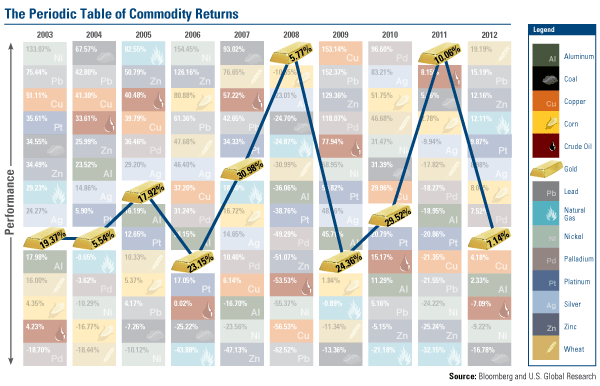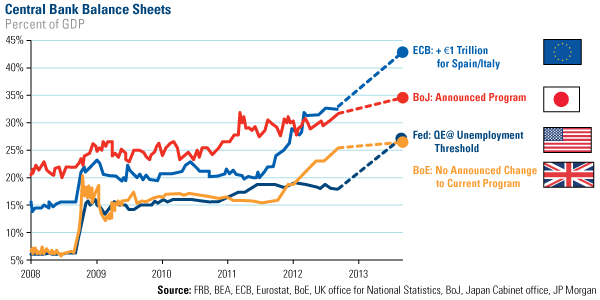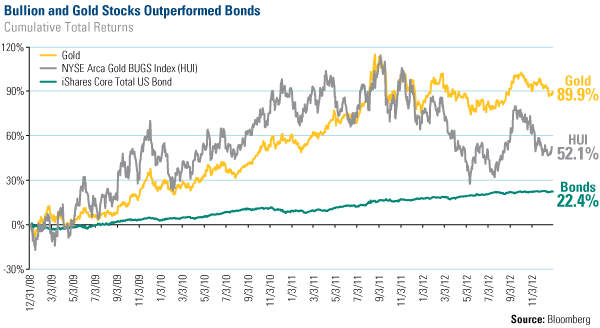Our ever-popular Periodic Table of Commodity Returns has been updated through 2012. Investor Alert readers love this chart as it shows a decade of results across 14 different commodities, providing strikingly rich information in a very familiar format.
Last year, 11 commodities rose in value, with wheat rising as the top crop after seeing a significant decline in 2011. It was a similar rags-to-riches story for the next few leaders, including lead, zinc, natural gas and platinum, which all climbed double digits in 2012 after falling in 2011.
The Losers
Only three commodities declined over the year: Crude oil fell by 7% after rising 8% the previous year. Nickel declined for the second year in a row. In 2012, the metal lost 9% and in 2011, nickel fell another 24%.
Coal was the worst-performing commodity in 2012, falling nearly 17%. Coal’s been going through a rough spell lately; in fact, the commodity has not been king for five years (although it did record a 31% increase in 2010). As Global Resources Fund Portfolio Manager Evan Smith explained to listeners during our recent presentation, for the first time ever in the U.S., natural gas provided more electricity and power than coal did.
As you can see from the table, commodities often have wide price fluctuations from year to year given the many factors affecting supply and demand, such as government policies, union strikes, and currency volatility. That’s why when it comes to commodities and commodity producers, many investors “leave the driving” to active money managers who understand these specialized assets and the global trends affecting them.
Take gold and gold companies, for example. After investing in the mining industry for decades, we’ve taken note of several facts about gold that continue to surprise our investors.
Here are four of the latest:
1. Gold Has Been A Consistent Performer Over The Decade
While the precious metal did not shoot the lights out in 2012, gold’s bull rally goes on. It ended the year up 7%, making it a phenomenal twelth year in a row that gold rose in value. In a special gold bar version of the Periodic Table below, you can easily see gold’s rotation among the commodities from year to year.
What’s fascinating is the three-year rising pattern relative to other commodities that emerges when you focus on the bars. Over the past 10 years, gold has risen in position compared with the others for three years in a row, then fallen in relative position in the fourth year before repeating the cycle. Will it follow the same pattern and be in the top half of the Periodic Table in 2013?
2. Gold Should Remain A Hot Commodity In 2013
Considering the global easing cycle and the continuous running of monetary printing presses, I believe the Fear Trade will continue to be a driver of gold over the next several months. Take a look at the projected rise in the balance sheets as a percent of GDP from the European Central Bank, the Bank of Japan, the Federal Reserve and the Bank of England over 2013. The ECB is estimated to have a balance sheet that is nearly 50% of its GDP by the end of the year. The Bank of Japan is right behind the ECB, with its balance sheet projected to be nearly 35% of GDP. As Mike Shedlock of Mish’s Global Economic Trend Analysis said, “The race is on to see which central bank can load up its balance sheet with the most garbage the fastest.”
My friend Ian McAvity also summed it up well in his Deliberations on World Markets: “Gauging from the panicky actions of the major central banks, I would still prefer to own gold than their paper.” With the monetary printing presses warm and real interest rates in the red, gold will likely glimmer for another year.
3. Gold Is The Least Volatile Commodity On The Table
Given the fact that every gold move is analyzed and dissected by the media, it may surprise you that this precious metal was actually the least volatile of the 14 commodities. Its rolling 12-month standard deviation (sigma) over the past 10 years has been 14%, compared to the most volatile commodity, (nickel), which has a rolling 12-month sigma of nearly 60%.
Here’s another way to look at the surprisingly low volatility of gold. Take a look at the frequency of 10% moves up or down over any 20 trading days. The metal is only slightly more volatile than the S&P 500. Gold companies, crude oil and the MSCI Emerging Markets Index have all experienced more up and down moves than gold.
Whereas card counting at a Blackjack table can get you booted from casinos and barred for life, as an investor, you are allowed to take full advantage of counting the 10% moves.
Over 2013, you can count on gold moving in either direction, so even if the metal experiences extreme volatility to the downside, regardless of what the headlines report, Investor Alert readers know that any dip in price offers potential buying opportunities. Keep in mind though, that it’s prudent to invest only 5% to 10% of your total portfolio in gold and gold stocks.
4. The Last Four Years Were Better Than You Thought
Recently, I showed how the S&P 500 Index and gold bullion significantly outperformed the iShares Core Total US Bond ETF. Many investors asked about gold stock performance. As you can see below, the NYSE Arca Gold BUGS Index (HUI) experienced quite a gain, increasing more than 50% on a cumulative basis since the beginning of 2009. Both considerably outperformed the bond investment.
What’s sensational news to precious metals investors sometimes doesn’t make the cut as breaking news. Shortly before I was scheduled to talk to CNBC about silver on Friday, my appearance was canceled as reporters preempted my investing insights for what was viewed as a more sensational story about millionaire and fugitive John McAfee.
In the meantime, I’ll continue sharing these fascinating facts about gold, silver and other commodities with investors at Cambridge House’s Resource Investment Conference in Vancouver and the World Money Show in Orlando, Florida. Hope to see you there!
U.S. Global Investors, Inc. is an investment management firm specializing in gold, natural resources, emerging markets and global infrastructure opportunities around the world. The company, headquartered in San Antonio, Texas, manages 13 no-load mutual funds in the U.S. Global Investors fund family, as well as funds for international clients.
For more updates on global investing from Frank and the rest of the U.S. Global Investors team, follow us on Twitter at www.twitter.com/USFunds or like us on Facebook at www.facebook.com/USFunds. You can also watch exclusive videos on what our research overseas has turned up on our YouTube channel at www.youtube.com/USFunds.
Please consider carefully a fund’s investment objectives, risks, charges and expenses. For this and other important information, obtain a fund prospectus by visiting www.usfunds.com or by calling 1-800-US-FUNDS (1-800-873-8637). Read it carefully before investing. Distributed by U.S. Global Brokerage, Inc.
Past performance does not guarantee future results.
Foreign and emerging market investing involves special risks such as currency fluctuation and less public disclosure, as well as economic and political risk. Because the Global Resources Fund concentrates its investments in a specific industry, the fund may be subject to greater risks and fluctuations than a portfolio representing a broader range of industries.
All opinions expressed and data provided are subject to change without notice. Some of these opinions may not be appropriate to every investor.
The S&P 500 Stock Index is a widely recognized capitalization-weighted index of 500 common stock prices in U.S. companies. The NYSE Arca Gold BUGS (Basket of Unhedged Gold Stocks) Index (HUI) is a modified equal dollar weighted index of companies involved in gold mining. The MSCI Emerging Markets Index is a free float-adjusted market capitalization index that is designed to measure equity market performance in the global emerging markets. Standard deviation is a measure of the dispersion of a set of data from its mean. The more spread apart the data, the higher the deviation. Standard deviation is also known as historical volatility.
- English (UK)
- English (India)
- English (Canada)
- English (Australia)
- English (South Africa)
- English (Philippines)
- English (Nigeria)
- Deutsch
- Español (España)
- Español (México)
- Français
- Italiano
- Nederlands
- Polski
- Português (Portugal)
- Português (Brasil)
- Русский
- Türkçe
- العربية
- Ελληνικά
- Svenska
- Suomi
- עברית
- 日本語
- 한국어
- 简体中文
- 繁體中文
- Bahasa Indonesia
- Bahasa Melayu
- ไทย
- Tiếng Việt
- हिंदी
Gold: Four Facts You May Not Know
Published 01/22/2013, 03:15 PM
Updated 07/09/2023, 06:31 AM
Gold: Four Facts You May Not Know
Latest comments
Loading next article…
Install Our App
Risk Disclosure: Trading in financial instruments and/or cryptocurrencies involves high risks including the risk of losing some, or all, of your investment amount, and may not be suitable for all investors. Prices of cryptocurrencies are extremely volatile and may be affected by external factors such as financial, regulatory or political events. Trading on margin increases the financial risks.
Before deciding to trade in financial instrument or cryptocurrencies you should be fully informed of the risks and costs associated with trading the financial markets, carefully consider your investment objectives, level of experience, and risk appetite, and seek professional advice where needed.
Fusion Media would like to remind you that the data contained in this website is not necessarily real-time nor accurate. The data and prices on the website are not necessarily provided by any market or exchange, but may be provided by market makers, and so prices may not be accurate and may differ from the actual price at any given market, meaning prices are indicative and not appropriate for trading purposes. Fusion Media and any provider of the data contained in this website will not accept liability for any loss or damage as a result of your trading, or your reliance on the information contained within this website.
It is prohibited to use, store, reproduce, display, modify, transmit or distribute the data contained in this website without the explicit prior written permission of Fusion Media and/or the data provider. All intellectual property rights are reserved by the providers and/or the exchange providing the data contained in this website.
Fusion Media may be compensated by the advertisers that appear on the website, based on your interaction with the advertisements or advertisers.
Before deciding to trade in financial instrument or cryptocurrencies you should be fully informed of the risks and costs associated with trading the financial markets, carefully consider your investment objectives, level of experience, and risk appetite, and seek professional advice where needed.
Fusion Media would like to remind you that the data contained in this website is not necessarily real-time nor accurate. The data and prices on the website are not necessarily provided by any market or exchange, but may be provided by market makers, and so prices may not be accurate and may differ from the actual price at any given market, meaning prices are indicative and not appropriate for trading purposes. Fusion Media and any provider of the data contained in this website will not accept liability for any loss or damage as a result of your trading, or your reliance on the information contained within this website.
It is prohibited to use, store, reproduce, display, modify, transmit or distribute the data contained in this website without the explicit prior written permission of Fusion Media and/or the data provider. All intellectual property rights are reserved by the providers and/or the exchange providing the data contained in this website.
Fusion Media may be compensated by the advertisers that appear on the website, based on your interaction with the advertisements or advertisers.
© 2007-2025 - Fusion Media Limited. All Rights Reserved.
